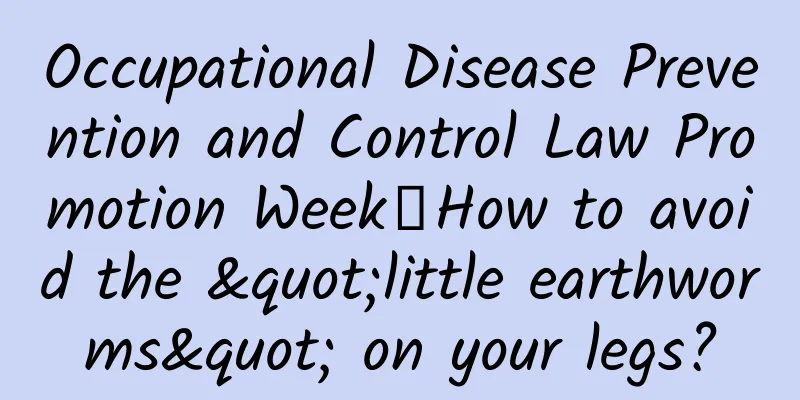Occupational Disease Prevention and Control Law Promotion Week丨How to avoid the "little earthworms" on your legs?

|
The Occupational Disease Prevention and Control Law Publicity Week is in full swing. I believe that everyone has a deeper understanding of statutory occupational diseases. But did you know that there is a large category of diseases that are related to work and are also seen in non-occupational populations, so not every case has an occupational history. When this type of disease occurs in occupational workers, due to exposure to occupational harmful factors, the original disease will be aggravated, accelerated or recurred. This type of disease is called work-related disease. Broadly speaking, occupational diseases also belong to work-related diseases. Common work-related illnesses, Including tension headaches caused by work stress, Peptic ulcer caused by high temperature work, Cervical spondylosis and mouse hand of "sedentary people", Teachers' pharyngitis and varicose veins in the lower limbs, etc. Today, I will introduce to you one of the work-related diseases that is easily overlooked: varicose veins of the lower limbs. Varicose veins of the lower limbs are common in teachers, surgeons, nurses, police officers and other occupations that require long periods of standing, or bank tellers, cashiers, office clerks and other people who sit for long periods of time. The main manifestations are dilation, elongation and tortuosity of the great saphenous veins of the lower limbs. It is a venous valvular disease that does not heal on its own and worsens year by year. There are no symptoms in the early stage. As the disease progresses, the affected limbs gradually become sore, weak, heavy, painful and itchy. In severe cases, complications such as leg ulcers or superficial phlebitis are often accompanied, and the skin becomes hard, ulcerated and blackened, forming "old rotten legs" and "ulcerative legs". The main causes of varicose veins: Weak vein walls, defective venous valves, and persistently elevated pressure in the superficial veins. When standing, the vertical gravity of the blood column increases the pressure on the lower limb veins. At the same time, the blood has to return to the heart from the farthest point, which can directly lead to damage of the great saphenous vein valve. Therefore, varicose veins of the great saphenous vein are more common in workers who stand for long periods of time. Depending on the severity of varicose veins, different treatment methods are chosen: 1. Patients with only small subcutaneous blood vessel dilation can be treated with elastic support (wearing elastic stockings or applying external pressure with elastic bandages) and drug treatment (intravenously active drugs such as flavonoids, saponins, etc.). 2. For patients with only vascular tortuosity, mild dilation, and no obvious discomfort, foam sclerosing agent injection can be used to close the dilated varicose veins. 3. For patients with moderate varicose veins, tortuous and protruding blood vessels in the lower limbs like earthworms, as well as lower limb soreness, swelling, and ulcer formation, minimally invasive treatment with radiofrequency ablation can be used. 4. For patients with severe varicose vein symptoms and obvious venous dilation, surgical treatments such as varicose vein stripping and high ligation of the great saphenous vein can be selected. Surgery is the only way to cure varicose veins of the lower limbs, but there is also the possibility of recurrence after surgery. Early detection and timely treatment, lifestyle changes and enhanced protection can effectively slow the progression of the disease. How to prevent: 01. Varicose veins have a genetic tendency, so you should prevent them early, exercise regularly, and strengthen your physical fitness. 02. Eat a balanced diet, prevent constipation, and avoid excessive obesity. 03. People who engage in standing work or heavy physical labor for a long time should wear medical elastic stockings to keep the superficial veins in a compressed state. 04. Pay attention to rest every day. Elevate your lower limbs when sleeping and massage moderately to promote blood circulation. 05. Avoid sitting for long periods of time and do moderate exercise (slow walking, cycling, etc.). Leg muscle contraction during activity can help venous blood return. Beware of varicose veins. Protect your legs. Take action! |
Recommend
Where is the clavicle of a woman?
It is said that women with collarbones are very b...
What to do with uterine fibroids? Chinese medicine remedies are effective
Uterine fibroids are a gynecological disease with...
How long can a 37-year-old woman who has gone through menopause live?
Most women will enter menopause in their 40s. Dur...
Retailnews: QR code mobile payment has been brought to the world by the Chinese
In the past few years, QR mobile payment services...
Does a woman's big belly mean she has too much moisture?
The season at the end of winter and the beginning...
Can seborrheic alopecia in girls be cured?
Nowadays, many people suffer from seborrheic alop...
How to achieve a flawless makeup look
We all know that girls in junior high and high sc...
What are the signs of pregnancy after ovulation?
As long as ovulation is normal, it can better hel...
5 key points to increase the success rate of pregnancy preservation in threatened abortion
A baby is the hope of every family, but sometimes...
What can women eat to get better quickly from anemia?
Anemia in women is usually caused by iron deficie...
What is the reason for nipple pain?
Breasts, as a major symbol of femininity, can act...
Are the hazards of sitting for a long time so serious?
Everyone knows that sitting for a long time is ba...
What is early pregnancy antenatal screening?
Now everyone's economic ability has been impr...
What does the ABC column of a car mean? What is the use of the ABC column of a car?
When we learn about some car parameters, we often...
Massage to relieve menstrual cramps
Dysmenorrhea is a relatively common gynecological...









